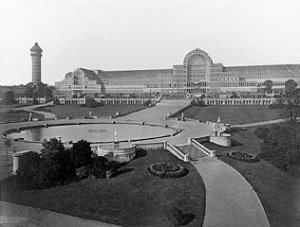The World’s Fair:
–Brendan Loftus
The World’s Fair started around the time of the Industrial Revolution. First, they started in European countries, and it gave them a chance to show off their progress in manufacturing, science and technology. After its early success in Europe, the fair expanded to other countries. The goal of the World’s Fair was to provide a beneficial competition and peaceful setting for numerous countries. However, the World’s fair was also a place of great nationalism and healthy rivalries. The World’s Fair expanded to more than manufacturing. It increased to other topics such as fine arts, fashion, agriculture, technology and more. They would normally last from around 3 weeks to 6 months. It took place in popular European locations such as London, England (1851, 1862, 1871-74), Paris, France (1855, 1867, 1878, 1889, 1900), and Vienna, Austria (1873). The World’s Fair is important because of the many historical inventions that were first released to the public at the World’s Fair.
In London, many exhibits were showcased at the World’s Fair; however, none were quite as extravagant as the glass walls showcased on the Crystal Palace, as shown in the picture above. The Crystal Palace contained over 100,000 exhibits and gave these displays to more than 14,000 viewers (Swift, 2006). Presentations were often randomly located throughout the palace and the overall goal was to educate the observer of all types of new knowledge.
In 1855, the World’s fair was held in Paris, France, and France wanted to have the fair to rival their economic competitor of Britain. Even though the fair lost money, the Palace of Industry was built in France and held nearly 5 million observers during the exhibition. France’s show contained mainly industry, but they also included fine arts in 1855 because France was known for their artistic abilities.
Paris, France held the 1889 World’s Fair and this World’s Fair was significant because it is when the Eifel Tower was introduced to the skyline of Paris. The Eifel Tower was used as the entrance of the show, but it was not there alone. Nearly 80 buildings contained exhibits displaying fine arts, agriculture, and shows dedicated to the “Social Economy” (Swift, 2006). The construction of the Eifel Tower was a remarkable political and economic achievement for the French government. The cost of the fair totaled to about 47 million francs and around one-fifth of that went towards the Galerie des Machines (Stamper, 1989). The Eifel Tower is still very relevant today, and it is astonishing to think about the time when it was first erected at the 1889 World’s Fair in Paris.

eifel tower
by andos_pics andos_pics, used under 
In 1873, the World’s Fair was held Vienna, Austria in order to give the country a chance to recover from their previous economic and political setbacks of the 1850s and 1860s. The country’s main exhibit was Palace of Industry. It also held many different types of theatrical shows held on different venues that were presented during the course of the Fair. However, the most innovative exhibit were the open-air concerts held at the Strauss pavilion (Swift, 2006). Vienna’s attempt at hosting a World’s Fair was much more laid back, but impressive nonetheless.
For more information on the European World’s Fair, click here
World’s Fair Citations:
SWIFT, ANTHONY. “World’s Fairs.” Europe 1789-1914: Encyclopedia of the Age of Industry and Empire. Ed. John Merriman and Jay Winter. Vol. 5. Detroit: Charles Scribner’s Sons, 2006. 2493-2506. World History in Context. Web. 8 Apr. 2014.
Stamper, J. W. (1989). The Galerie des Machines of the 1889 Paris World’s Fair (Vol. 30).
Swift, A. (2006). Gale World Hisotry in Context. (Gale, Editor, & Gale, Producer) Retrieved April 8, 2014, from World’s Fairs:
Photo Citations:
andos_pics. (Photographer). eifel tower [Web Photo]. Retrieved from https://www.flickr.com/photos/aganderson/3028372889/in/photolist-5BBcKF-5bH8Ds-5iBxCh-95WphF-4qZbC1-5bHcH7-63VBqj-67JGWh-7oRUos-7oN3j8-63Rogg-eUkd4r-7oRTcL-7oN2dk-7oRTBq-DTa9i-961aRo-7oRT3G-7oRST5-zmv8Y
Delamotte, Philip Henry. (Photographer). Crystal Palace General view from Water Temple [Photo]. Retrieved from http://en.wikipedia.org/wiki/File:Crystal_Palace_General_view_from_Water_Temple.jpg

